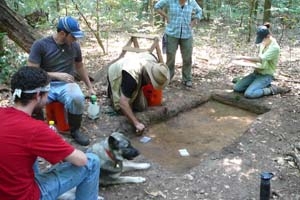Social Sciences
Story of Great Dismal Swamp Revealed in New Book

Professor Daniel Sayers (center) working with students in the Great Dismal Swamp.
In 2010, associate anthropology professor and historical archaeologist Daniel Sayers received a three-year, $200,000 We the People Collaborative grant from the National Endowment for the Humanities to support his Great Dismal Swamp Landscape Study (GDSLS). The study is an ongoing and interdisciplinary exploration of the resistance communities that lived in the swamp interior from the 1600s through the Civil War.
In December, Sayers published the results of his research as a book, A Desolate Place for a Defiant People: The Archaeology of Maroons, Indigenous Americans, and Enslaved Laborers in the Great Dismal Swamp (University of Florida Press and The Society for Historical Archaeology).
What exactly is the Great Dismal Swamp and how did you first become interested in it?
The Great Dismal Swamp is kind of like it sounds: a big water-laden, tree-dense, and critter-filled place just south of Norfolk, Virginia. It is big enough to extend well into North Carolina as well … about 190 square miles in size today.
The US Fish and Wildlife Service manages and protects the area today, and I work with them to explore its social history. We who know it well don’t think of it as “dismal,” but before the Civil War most people did—and it was 2,000 square miles in size back then.
I became interested in it my first few weeks at William and Mary as a doctoral student. My advisor, Marley Brown III, told me about it and how Maroons, or African Americans who escaped slavery, may have formed their own communities in it. I was hooked at the thought of it.
Who are the people who have lived in the swamp interior, and what have you unearthed about them?
Based on our work in the swamp, it is clear that communities of people lived in the interior from the time of the Jamestown’s founding (1607) up through the Civil War. We know that only people who had enough with the oppressive and exploiting world of colonialism and enslavement outside the swamp joined these interior communities. So, African American Maroons certainly were major contributors to interior communities, as were Indigenous Americans, and, possibly indentured servants.
Communities formed on areas of relatively dry ground that pepper the swamp landscape. Residents lived in raised cabins, harvested daily used materials from the swamp, and avoided contact with the outside world as much as was possible. The communities persisted for more than 250 years, even if they changed dramatically here and there across those centuries.
No one knew this history, with reasonable certainty, until archaeology was used to demonstrate it.
How did the book idea first come about?
My mentor and committee member, Marley (mentioned previously), nominated my doctoral dissertation, which I completed in 2008, for the Society for Historical Archaeology (SHA) dissertation award for 2009. Winners of the award get prize money, and the SHA works with the University of Florida Press to see it published.
My dissertation didn’t win, but it came in a very close second. So, the award committee for the SHA offered to help me publish through the University Press of Florida.
At the time, I thought it would be a dissertation-turned-book kind of thing. But our annual archaeology field schools in the Dismal Swamp between 2009 and 2013 kind of changed that. Because we found so much in those seasons, and I have had a decent amount of time for further thinking, the content and analytical approach of the book are quite different from the 2008 dissertation. For example, we have recovered evidence, which we didn’t have before, of big changes in interior community practices and organization after 1800.
What is the GDSLS Archaeology Field School?
The Great Dismal Swamp Landscape Study archaeology field school is supported by AU and was held every summer for 5 years; I took a break from it in 2014. Students in our GDSLS field school take it for credit, and we spend 5–7 weeks (depending on the year) working in the Dismal Swamp and living in a big rented house in one of the neighboring towns, like Suffolk, Virginia.
The class is basically an intensive learning and community-building operation where students learn to do archaeological excavation, artifact analysis, and any of a host of skills-building activities while also working and living as a team. We may be running it again this summer (May and June 2015).
Tell us a little bit about the logistical challenges of exploring the swamp.
Archaeology is an expensive and laborious line of work to begin with. Working in a 190-square mile swamp exacerbates those problems. With few exceptions, there are no “easy access” sites out there; you’re always wet with swamp water; and, getting the several hundred pounds of gear to and from a site is quite difficult. You can get lost very easily, so one has to be very aware at all times of where they are.
In summer months, mosquitoes, snakes, ticks, and bears enjoy messing with you one way or another (bears, usually, through chewing up equipment). I’ve worked out there alone a lot, but when I am leading people in, getting them safely to and from the swamp each day can be stressful. It’s all big fun though.

